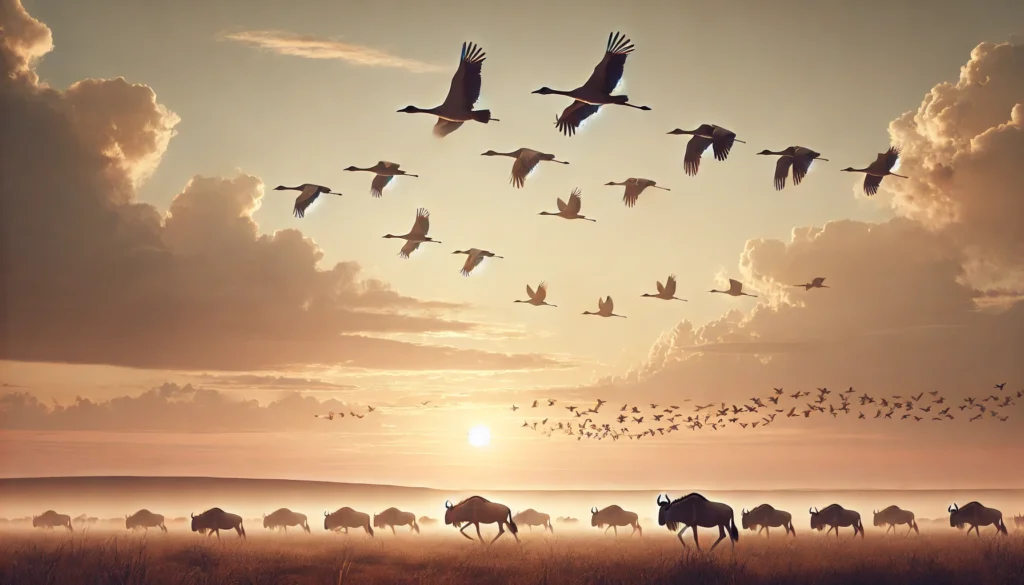Every year, millions of animals embark on incredible journeys across the globe. From the soaring flights of birds to the deep-sea dives of whales, migration is a testament to the resilience and adaptability of life. These journeys are not simply random movements; they are driven by instinct, survival, and the search for better conditions.
What is Migration?
Migration is the seasonal movement of animals from one region to another. It’s often triggered by changes in weather, food availability, or breeding opportunities. These journeys can span thousands of miles and involve complex navigation skills.
Why Do Animals Migrate?
Animals migrate for a variety of reasons:
- Food Availability: Many animals follow the availability of food sources, such as migrating caribou following the growth of new vegetation.
- Breeding Opportunities: Some animals migrate to specific breeding grounds where conditions are optimal for raising their young, like sea turtles returning to their natal beaches.
- Climate Conditions: Animals may migrate to escape harsh weather conditions, such as birds flying south for the winter.
- Avoiding Predators: Migration can help animals avoid predators that are concentrated in certain areas.
Examples of Incredible Migrations:
- Monarch Butterflies: These delicate insects travel thousands of miles from Canada and the United States to overwinter in Mexico.
- Arctic Terns: These birds undertake the longest migration of any animal, flying from the Arctic to the Antarctic and back each year.
- Wildebeest: Millions of wildebeest migrate across the Serengeti plains in Africa, following the rains and fresh grazing.
- Humpback Whales: These whales migrate from their feeding grounds in polar regions to their breeding grounds in warmer waters.
- Salmon: Salmon migrate from the ocean to freshwater rivers to spawn, often returning to the exact river where they were born.
The Challenges of Migration:
Migration is a perilous journey, filled with challenges:
- Predation: Migrating animals are vulnerable to predators along their route.
- Weather Conditions: Storms, extreme temperatures, and other weather events can pose significant risks.
- Habitat Loss: Human development and habitat destruction can disrupt migration routes and reduce food availability.
- Pollution: Pollution can contaminate food sources and water, affecting the health of migrating animals.
- Physical Exertion: Long-distance migrations require immense physical endurance.
The Science of Navigation:
Animals use a variety of cues to navigate during migration:
- Sun and Stars: Many animals use the position of the sun and stars to orient themselves.
- Earth’s Magnetic Field: Some animals, like birds and sea turtles, can detect and use the Earth’s magnetic field for navigation.
- Landmarks: Animals may use landmarks, such as mountains and rivers, to guide their way.
- Scent and Sound: Some animals use scent and sound cues to navigate.
- Innate Instincts: Many animals have innate instincts that guide their migration.
The Importance of Conservation:
Migratory animals are facing increasing threats due to habitat loss, climate change, and human activities. Conservation efforts are crucial to protect these incredible journeys and ensure the survival of these species.
Conclusion:
The marvel of migration is a testament to the power of nature and the resilience of life. These incredible journeys connect ecosystems across the globe and remind us of the interconnectedness of our planet. Protecting migratory animals and their habitats is essential for preserving the biodiversity and health of our world.
Reference Links:
- National Geographic: Animal Migration – https://www.nationalgeographic.org/encyclopedia/animal-migration/
- WWF: Migratory Species – https://www.worldwildlife.org/species/directory?direction=desc&sort=extinction_status&type=migratory
- Smithsonian’s National Zoo: Animal Migration – https://nationalzoo.si.edu/animals/animal-migration
- Wikipedia: Animal Migration – https://en.wikipedia.org/wiki/Animal_migration



